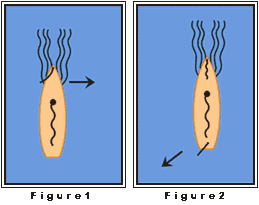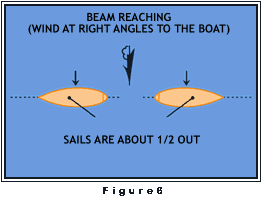Before leaving the mooring, let's get a couple of basic terms clear: starboard and port are two terms in constant use on board a boat. Starboard is right and port is left when facing forward (toward the bow). Some remember this by the fact that "port" and "left" have the same number of letters. It's been said that the words came from sailing ships of long ago that used a sweep, or oar, for steering. It was called the "steering board" and was over the right side of the boat when one faced the bow. Thus the right side was called the "steering board" side and later, the starboard side. The left side was clear to lay next to a dock while the boat was in port and became the "port" side. Now we're ready to sail away, but since the boat is headed directly into the wind at a mooring and is not moving through the water, it is what we call "in irons" or "in stays." This can happen at other times when a boat attempts to change tacks by turning into the wind, is stopped by a wave, and loses "steerageway" or "headway." In order to steer a boat, water must be flowing past the rudder. If the boat is "dead in the water" (motionless) the rudder is useless, so the sails have to be used in its place. Because the boat is pointing directly into the wind, the sails are "luffing" (shaking). To "fill" the sails, you will have to place the boat at an angle to the wind. Usually this angle is 45 degrees or more, and when the boat reaches this position, the sails will fill with wind and the boat will start moving forward. Until that point, however, the sails have to be manually forced out against the wind to fill them. This is called "backing" the sail. If you want to turn the bow of the boat to starboard (to the right), you hold the jib out to port as in Figure 1.The wind hits the port side of the jib and pushes the bow to starboard. After the boat is pushed 45 degrees to the wind, the jib is released and trimmed normally on the starboard side. Though backing the jib is the fastest and surest method of falling off onto the desired tack, there are other ways. If the boat is drifting backward as in Figure 2, put the tiller to starboard. The rudder will turn the stern of the boat in the direction of the arrow and the boat will "fall off" onto the port tack.

You might be sailing a small boat that has no jib. In that case, you can push the main out against the wind. This starts the boat moving backward and turns the stern to the opposite direction of the side that you are holding the main. In other words, if you back the main to the starboard side, the stern will go to port as in Figure 3. Help the boat to turn by putting the tiller to starboard as described in Figure 2. If you are sailing a yawl or a ketch, you can back the mizzen (aftmost smaller sail) out against the wind in the same manner, and with the same effect, as backing the main of a small boat. Note Figure 4.


The standard procedure when leaving a mooring is for a crew member to untie the mooring line, but hold on to the end of it (or, if possible, use it to pull the boat forward to gain a little forward momentum) while another crew member backs the jib. When the bow is definitely swinging in the desired direction, the mooring line is released and you're off sailing. As the boat starts moving forward, the rudder becomes effective. Though it eventually becomes automatic, at first one has to think which way to push the tiller to steer a sailboat. As the boat sails along, water flows past the rudder. When the rudder is turned, it deflects the water flow and pushes the stern opposite from the direction of the deflected flow. Study Figure 5.

The hull and keel of the boat act as a pivotal point, so the bow goes in the opposite direction of the stern. When leaving a dock in a cruising boat under power, one often sees the new owner try to swing the bow out too sharply. The stern bumps along the pilings because the skipper is so intent on turning the bow, he forgets he is actually throwing the stern toward the dock. To turn to port you have to push the tiller to starboard and vice-versa, which confuses many beginners. It's interesting to note that the fireman who steers the rear wheels of a hook-and-ladder truck is called the "tillerman." The theory is the same. There's no easy way to remember how to steer a sailboat. Practice is the key. Just sail on a "beam reach" (see Figure 6) and make a series of small turns to get the feel of it.

| Contents | 1 | 2 | 3 | 4 | 5 | 6 | 7 | 8 | 9 | 10 | 11 | 12 | 13 | 14 | 15 | 16 | 17 | 18 | 19 |
[Previous Chapter] [Next Chapter]